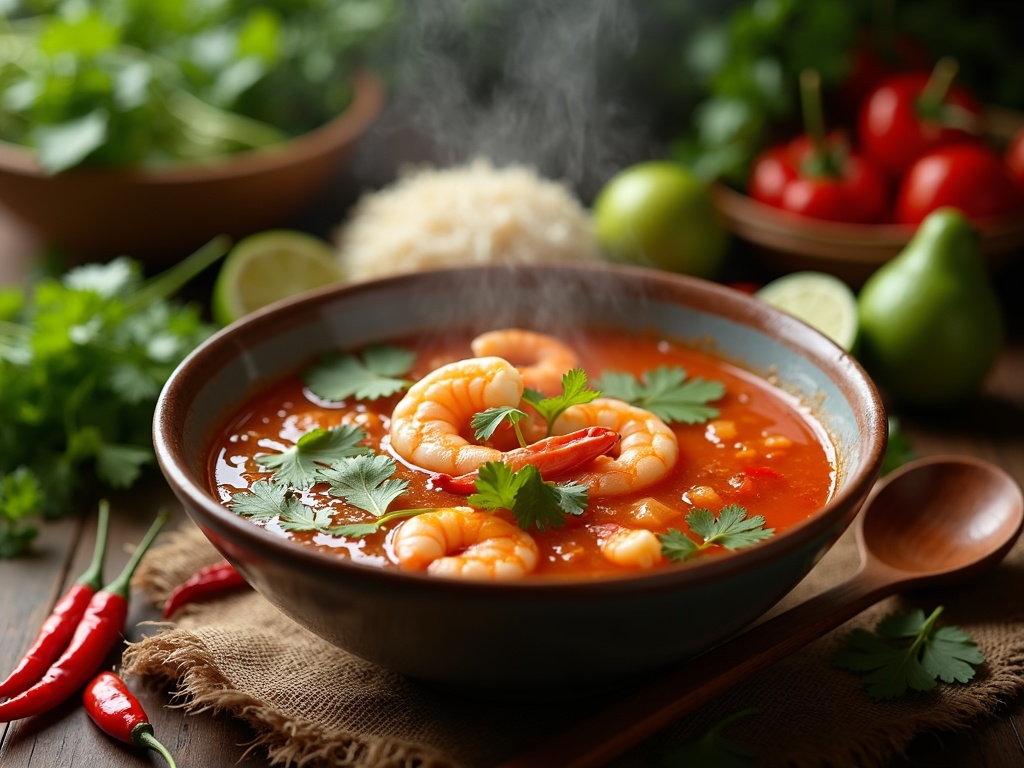Tom Yum Goong captures Thai cuisine’s essence with its perfect balance of sour, spicy, and aromatic flavors, making it a global ambassador for Thailand’s culinary heritage. This iconic soup combines fragrant ingredients like lemongrass, galangal, and kaffir lime leaves with fresh shrimp to create a dish that’s both invigorating and comforting, while also inspiring creative interpretations across different cuisines worldwide.
Find In This Article
Key Takeaways
- The soup exists in two main styles: Tom Yum Nam Kon (creamy with coconut milk) and Tom Yum Nam Sai (clear broth), each offering distinct flavor experiences.
- Fresh ingredients are essential for authentic flavor, particularly lemongrass, galangal, kaffir lime leaves, Thai chilies, and lime juice.
- Tom Yum Goong has significant health benefits, containing approximately 150 calories per serving with 20g of protein while remaining low in fat and carbohydrates.
- The dish has inspired numerous international variations, including tom yum pizza, pasta, cocktails, and fusion dishes that incorporate its distinctive flavor profile.
- In Thai culture, the soup holds special significance beyond everyday meals, frequently appearing at important gatherings and serving as a communal dish that brings people together.
A Spicy Thai Soup That’s Taking Over the World
Tom yum goong captures the essence of Thai cuisine with its perfect balance of sour, spicy, and aromatic flavors. This iconic soup has become a global ambassador for Thailand’s rich culinary heritage, finding its way onto menus in virtually every Thai restaurant worldwide. I’ve watched this soup transform from a local specialty to an international sensation that’s now inspiring chefs across different cuisines.
From Traditional Dish to Global Phenomenon
The traditional preparation of tom yum goong stays true to its roots with a fragrant broth infused with lemongrass, galangal, kaffir lime leaves, and Thai bird’s eye chilies. Fresh prawns or shrimp serve as the protein base, adding a sweet seafood flavor that contrasts beautifully with the sour lime juice and fish sauce. This combination creates a soup that’s simultaneously invigorating and comforting.
In Thailand, this soup holds special significance beyond everyday meals. It frequently appears at important family gatherings, weddings, and religious festivals. The shared experience of enjoying this fiery, aromatic soup brings people together, making it more than just food—it’s part of Thailand’s cultural fabric.
The global popularity of tom yum goong has sparked creative interpretations across different cuisines. Innovative chefs have incorporated its distinct flavor profile into surprising new dishes:
- Tom yum pizza topped with shrimp, mushrooms, and a spicy-sour sauce
- Tom yum pasta featuring the soup’s signature herbs and spices in a creamy sauce
- Tom yum cocktails that blend the soup’s aromatic elements with spirits
- Tom yum-flavored potato chips, instant noodles, and snack foods
These fusion creations show how versatile and adaptable the flavor profile can be, allowing people worldwide to experience Thai tastes in familiar formats. The soup’s complex flavor has also influenced how chefs approach spice and sourness in their cooking, encouraging bolder flavor combinations.
I’ve found that making tom yum goong at home can be just as rewarding as ordering it at a restaurant. The ingredients might seem exotic if you’re unfamiliar with Thai cooking, but many Asian markets now carry these staples. The explosive aroma that fills your kitchen when the herbs hit the hot broth is worth the effort of sourcing authentic ingredients. For another taste of Thailand’s vibrant flavors, you might enjoy trying a Thai beef salad alongside your tom yum soup.
What makes tom yum goong particularly special is how it introduces people to the fundamental elements of Thai cuisine—the balance of heat, acidity, saltiness, and herbaceous notes. For many, this soup serves as the gateway to exploring the broader landscape of Thai food, encouraging culinary adventure and appreciation for Thailand’s cooking techniques.
Essential Ingredients for the Perfect Bowl
Fresh ingredients make all the difference when preparing an authentic Tom Yum Goong. This iconic Thai soup balances sour, spicy, and savory notes to create a flavor explosion that’s both comforting and invigorating.
The Star Players
Fresh shrimp forms the foundation of Tom Yum Goong, with 10-20 pieces per serving providing the perfect amount. I prefer using medium to large shrimp with shells intact during cooking to enhance the broth’s flavor, then removing the shells before serving.
The aromatic trio that gives Tom Yum its signature fragrance includes:
- Kaffir lime leaves: These glossy, double-lobed leaves release citrusy oils that can’t be substituted.
- Lemongrass: Crush the stalks before adding to release their lemony essence.
- Galangal: Often confused with ginger, galangal has a sharper, piney flavor that’s essential (not interchangeable with regular ginger).
The soup’s distinctive flavor profile comes from the perfect balance of:
- Fish sauce for umami depth.
- Fresh lime juice for brightness (added toward the end of cooking).
- Thai chilies for heat (you can adjust the amount based on your spice preference).
Supporting Ingredients
Several ingredients round out the soup’s complexity:
Mushrooms add earthy notes and absorptive texture – straw mushrooms are traditional, but oyster mushrooms make an excellent substitute. Thinly sliced shallots contribute subtle sweetness and depth, while fresh cilantro brightens the finished bowl.
I can’t overstate how important using fresh ingredients is for an authentic Tom Yum experience. Pre-packaged pastes might seem convenient, but they simply can’t match the vibrant flavors of fresh herbs and aromatics.
For a complete Thai meal experience, consider pairing your Tom Yum Goong with a refreshing Thai beef salad that complements the soup’s flavors with its cool crispness.
The best Tom Yum has a clear, reddish-orange broth that’s both aromatic and packed with flavor. Each ingredient plays its part in creating that perfect balance of hot, sour, and savory that makes this soup so beloved around the world.
Your Guide to Making Tom Yum Goong
Tom Yum Goong is a fragrant Thai soup that’s captured hearts worldwide with its perfect balance of sour, spicy, and savory flavors. I’ve made this iconic dish countless times, and I’m excited to share practical tips that will help you create authentic Tom Yum Goong in your kitchen.
Cooking Methods and Timing
The traditional simmering method delivers the most authentic flavor profile for Tom Yum Goong. Start by creating a flavorful broth base with lemongrass, galangal, kaffir lime leaves, and shallots. Let these aromatics simmer gently for about 15-20 minutes to extract their essential oils and flavors before adding other ingredients.
When it comes to cooking the shrimp (goong), timing is critical. Add them to the hot broth for just 5-7 minutes – this sweet spot ensures they’re fully cooked but prevents that unpleasant rubbery texture that comes from overcooking. You’ll know they’re perfectly done when they turn pink and curl into a loose “C” shape.
You can adapt this classic soup to different cooking equipment:
- Stovetop method: The traditional approach using a pot over medium heat allows for gradual flavor development and easy monitoring.
- Instant Pot method: Perfect for busy weeknights, cutting the simmering time in half while still delivering intense flavor.
Soup Styles and Variations
Tom Yum Goong comes in two main styles, each with its distinct character:
- Tom Yum Nam Kon: The rich, creamy version that includes coconut milk. This style offers a slightly milder heat balanced by creaminess, making it accessible to those who prefer less spicy foods. The coconut milk adds a luxurious mouthfeel and helps mellow the sour notes.
- Tom Yum Nam Sai: The clear version – bright, intensely aromatic, and showcasing the pure flavors of the herbs and shrimp. This lighter style lets the punchy lemongrass and lime flavors shine through with nothing to mute their impact.
I’ve found that dietary restrictions don’t have to limit your enjoyment of this classic soup. Vegetarian options work wonderfully by replacing shrimp with firm tofu cubes, mushrooms (especially oyster or shiitake), or mixed vegetables. The key is keeping those essential aromatic ingredients that define Tom Yum’s character.
For a complete Thai meal experience, consider pairing your Tom Yum Goong with a refreshing Thai beef salad that offers contrasting textures and complementary flavors.
No matter which style or variation you choose, the soul of Tom Yum lies in its fresh ingredients. Don’t compromise on using fresh lemongrass, galangal, and lime leaves – dried alternatives simply can’t deliver the same bright, aromatic quality that makes this soup so special.
Remember that the chili heat level is entirely adjustable. Thai bird’s eye chilies pack serious heat, so start with fewer than you think you need – you can always add more later as you taste and adjust the soup. Crushing the chilies releases more heat, while keeping them whole provides a milder flavor.
With these guidelines, you’re well-equipped to create an authentic Tom Yum Goong that delivers that perfect balance of flavors that’s made this soup a global Thai food ambassador.
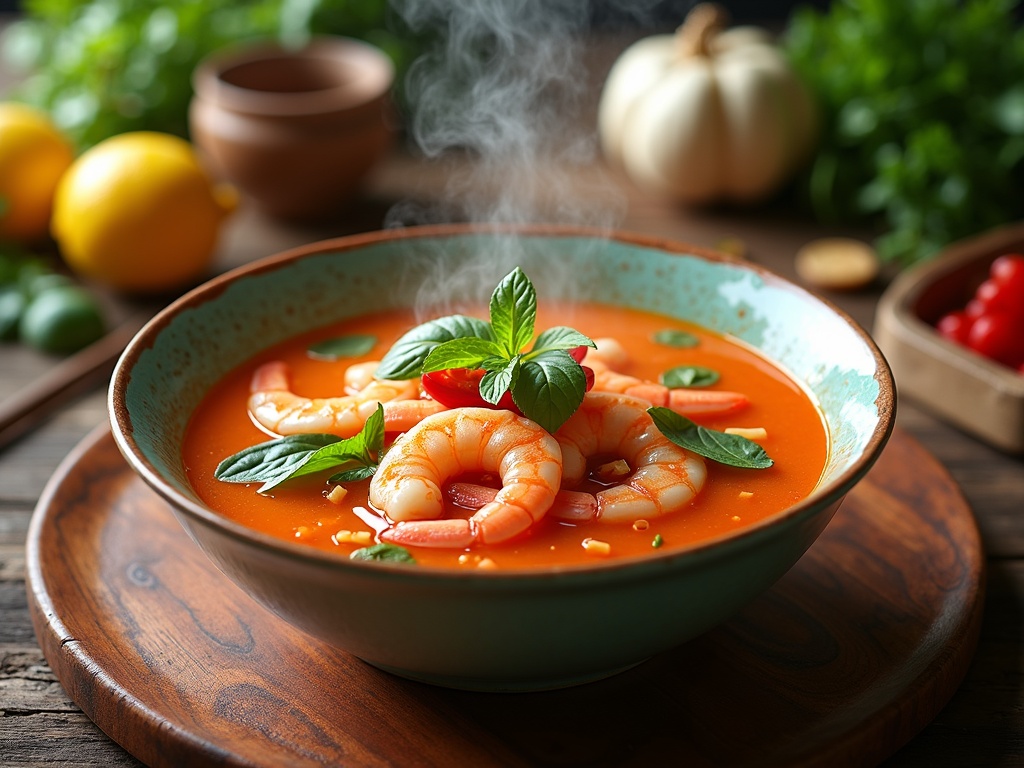
Health Benefits That Will Surprise You
Tom Yum Goong offers more than just incredible flavor. This aromatic Thai soup packs a nutritional punch that might just make it your new go-to meal option when you’re looking for something both delicious and healthy.
Impressive Nutritional Profile
A standard 250ml serving of Tom Yum Goong contains approximately 150 calories, making it a lighter option compared to many other soups. What really stands out is its protein content—around 20g per serving—which comes primarily from the succulent shrimp. I find this particularly beneficial for maintaining muscle mass and feeling satisfied after meals.
The soup is also remarkably low in fat (about 5g) and carbohydrates (approximately 6g), making it suitable for various dietary preferences. These macronutrient values can vary slightly depending on preparation methods and ingredient proportions, but the soup generally remains a balanced option that won’t derail your nutrition goals.
Powerful Medicinal Ingredients
Tom Yum Goong derives its health benefits from its core ingredients, each bringing unique properties to the bowl:
- Lemongrass contains citral, a compound with antimicrobial properties
- Galangal provides digestive benefits and contains antioxidant compounds
- Lime juice delivers a hefty dose of vitamin C, boosting immune function
- Chilies contain capsaicin, which may help boost metabolism
- Kaffir lime leaves have detoxifying properties that support liver health
The combination of ginger and chilies creates potent anti-inflammatory effects that can help reduce inflammation throughout the body. This makes Tom Yum Goong particularly valuable during cold and flu season or when recovering from illness.
I’ve found that incorporating this soup into my meal rotation provides a flavorful way to consume healing herbs and spices that might otherwise be challenging to include regularly in my diet. For an equally nutritious companion to this soup, you might enjoy a Thai beef salad that offers complementary health benefits and flavors.
The antioxidant-rich profile of Tom Yum Goong helps combat free radicals in the body, potentially reducing oxidative stress and supporting overall health. These benefits, combined with its relatively low calorie count and satisfying flavor profile, make this traditional Thai soup a smart addition to a health-conscious eating plan.
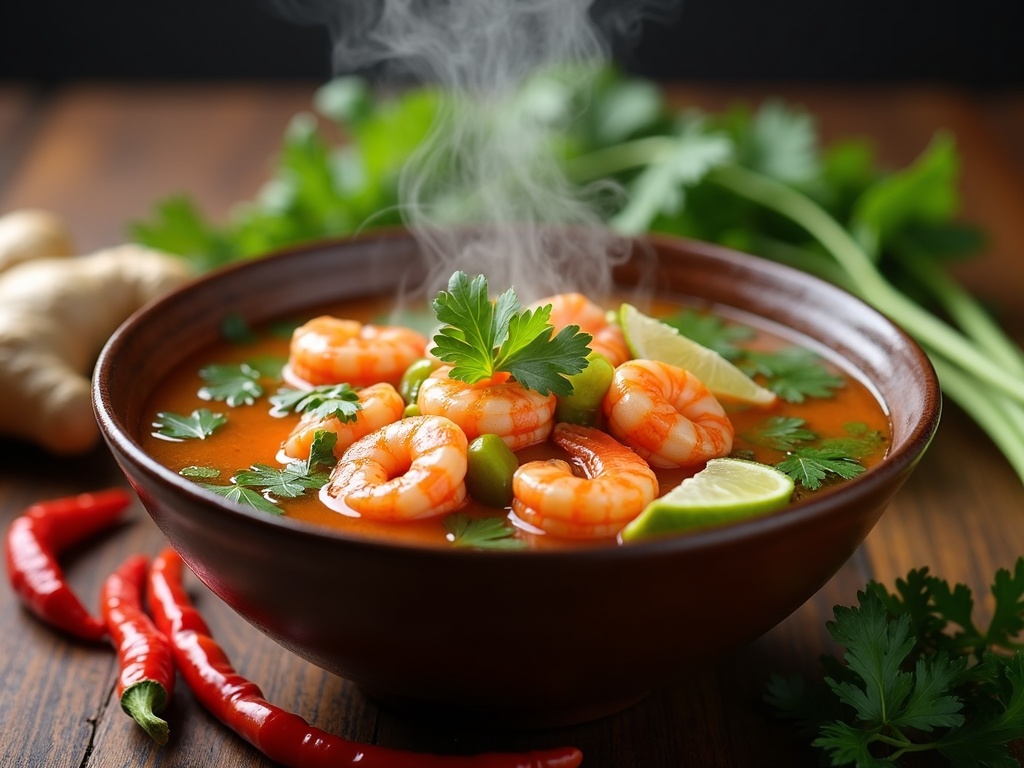
Regional Variations and Modern Twists
Tom Yum Goong, Thailand’s iconic hot and sour shrimp soup, takes on fascinating regional characteristics across the country. In central Thailand, the clear soup version (Tom Yum Nam Sai) dominates menus and home kitchens. This traditional variation maintains a bright, translucent broth where you can see all the herbs and shrimp swimming in the spicy liquid. The clear broth highlights the fragrant lemongrass, kaffir lime leaves, and galangal that give this soup its distinctive aroma.
Geographical Differences
Southern Thailand embraces a creamier adaptation known as Tom Yum Nam Khon, which incorporates coconut milk or evaporated milk. This version delivers a smoother, slightly sweeter profile while maintaining the soup’s characteristic tangy and spicy elements. The milky broth tempers some of the heat from the chilies, making it approachable for those who prefer a more balanced spice profile.
As Tom Yum has traveled beyond Thailand’s borders, it’s evolved into fascinating international variations. These include:
- Tom Yum pasta dishes that blend Italian techniques with Thai flavors
- Tom Yum fried rice incorporating the soup’s aromatic elements
- Tom Yum seafood boils popular in East Asian fusion restaurants
- Tom Yum ramen that marries Japanese noodle traditions with Thai spices
- Tom Yum risotto that infuses Italian rice with lemongrass and lime
The soup’s unmistakable flavor profile has inspired chefs around the world to experiment, creating entirely new dishes while honoring its Thai roots. I’ve even spotted Tom Yum flavored potato chips and instant noodles that attempt to capture its distinctive taste in convenience formats.
Dietary Adaptations
The rising interest in plant-based diets has sparked creative vegetarian and vegan interpretations. Mushrooms often replace shrimp in these versions, providing a meaty texture and umami flavor that satisfies without animal products. Varieties like oyster, king trumpet, and enoki mushrooms offer different textures and absorb the broth’s complex flavors beautifully.
Other modern variations cater to specific dietary needs while preserving the soul of Tom Yum Goong:
- Low-sodium versions that use herbs and spices more prominently
- Less spicy adaptations for those sensitive to heat
- Gluten-free preparations ensuring all ingredients meet dietary restrictions
For a delicious meal featuring similar flavors in a different format, try this Thai Beef Salad that shares many of the aromatic ingredients found in Tom Yum.
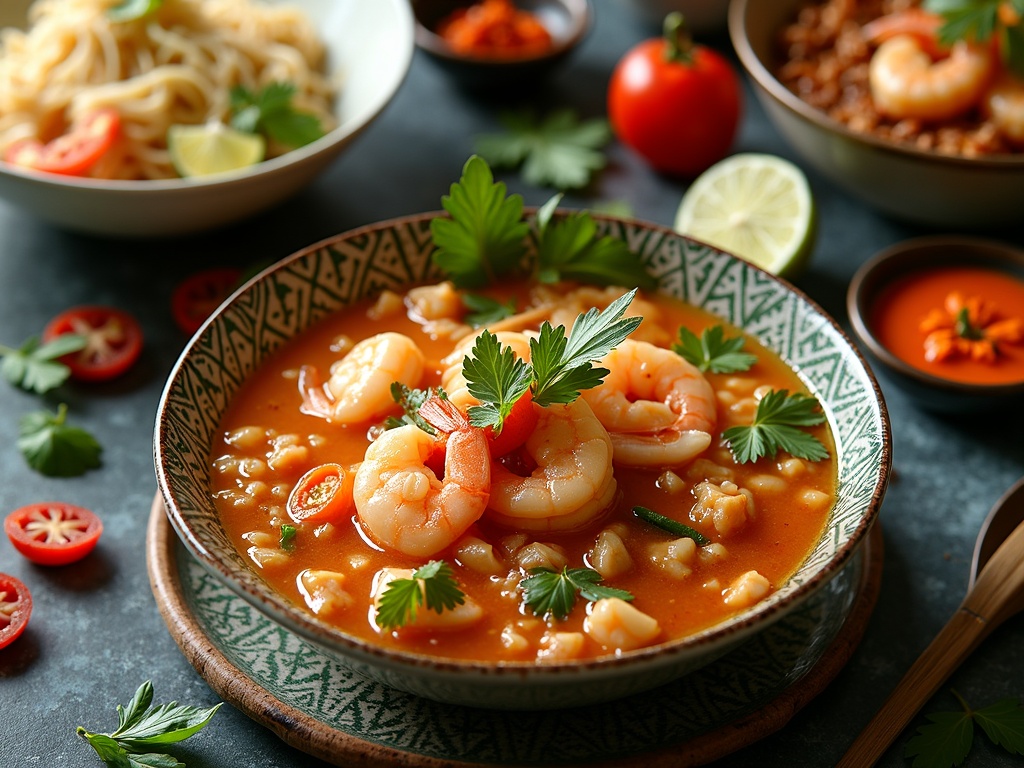
What Makes It Special
Tom Yum Goong stands out in the world of soups with its explosive flavor profile that awakens every taste bud. I’ve found that the magic of this iconic Thai dish lies in its perfect balance of contrasting elements – a harmony that few dishes achieve so masterfully.
A Symphony of Flavors
The bold combination of sour, spicy, and savory notes creates an unforgettable taste experience. Lemongrass, galangal, and kaffir lime leaves provide a citrusy foundation, while fresh chilies deliver that signature Thai heat. The addition of shrimp (goong) contributes a sweet seafood flavor that rounds everything out perfectly. Each spoonful tells a different story as these flavors dance together.
This isn’t just any soup – it’s a representation of Thai culinary philosophy. The dish embodies the Thai approach to food, where opposing flavors don’t fight but rather complement each other. Nothing is one-dimensional about Tom Yum Goong – it’s simultaneously refreshing and warming, light yet satisfying.
The ingredients in Tom Yum Goong showcase Thailand’s agricultural bounty. Fresh herbs and aromatics straight from local markets make this soup truly special:
- Fragrant lemongrass stalks add citrusy notes without acidity
- Galangal (Thai ginger) provides earthy warmth unlike regular ginger
- Kaffir lime leaves infuse aromatic oils essential to authentic flavor
- Fresh lime juice delivers that characteristic sourness
- Thai bird’s eye chilies contribute manageable but noticeable heat
What makes Tom Yum Goong particularly remarkable is how it brings people together. In Thai culture, soup is rarely enjoyed alone – it’s part of a shared meal experience where multiple dishes create a complete dining event. The large communal soup pot at the center of the table encourages conversation and connection, reflecting the importance of togetherness in Thai society.
Culinary Ambassador
Tom Yum Goong has proven remarkably adaptable while maintaining its cultural integrity. Variations exist across Thailand’s regions and have spread internationally with surprising flexibility. Some versions include coconut milk (Tom Yum Nam Khon) for a creamier experience, while others stick to the clear broth style (Tom Yum Nam Sai). You can even try a similar flavor profile in a different form with our Thai Beef Salad recipe.
The dish has gained tremendous popularity internationally, becoming an ambassador for Thai cuisine. Its distinct flavor profile helps introduce diners to Thai food’s complexity in an approachable way. Health-conscious eaters appreciate its nutritional benefits – packed with immunity-boosting ingredients like garlic, chilies, and herbs.
What truly sets Tom Yum Goong apart is how it refuses to be diminished in translation. Unlike many dishes that lose their soul when crossing borders, Tom Yum Goong maintains its essential character even when adapted for different markets. The combination of bright flavors, aromatic herbs, and fresh seafood creates a sensory experience that transcends cultural boundaries.
This special soup offers a window into Thailand’s culinary soul – representing both the country’s agricultural abundance and its sophisticated understanding of flavor balance. Each ingredient plays a crucial role in creating that unmistakable Tom Yum taste that has captivated food lovers worldwide.
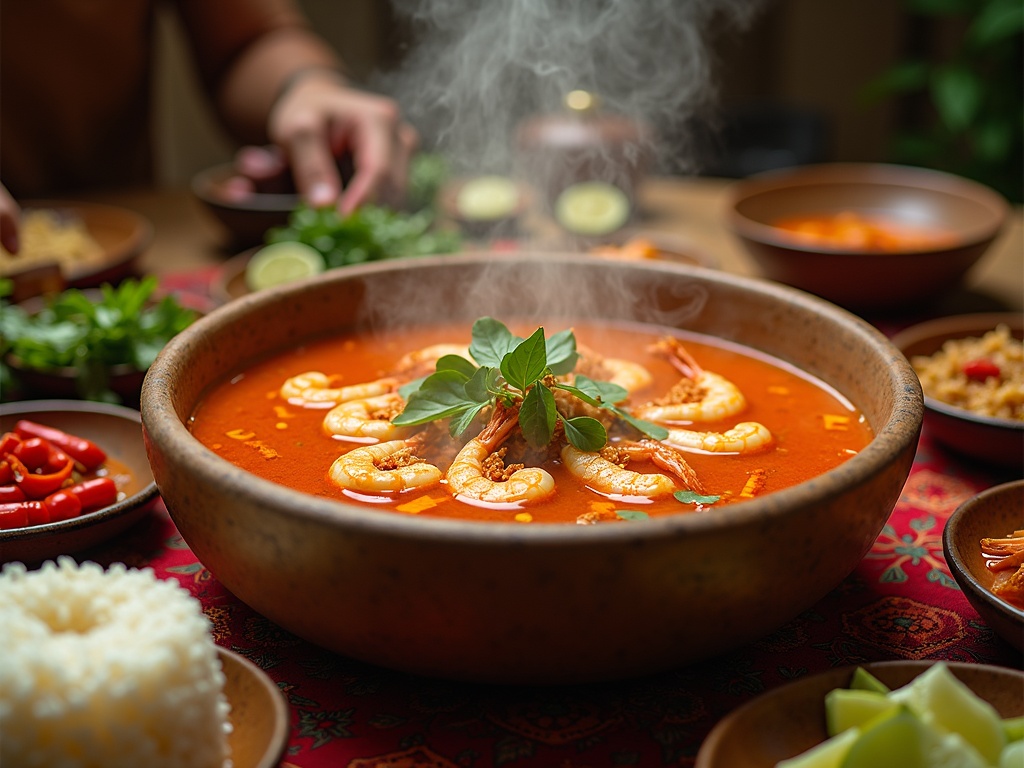
Sources:
Culinary Institute of Thailand, Healthline, Food & Beverage Magazine

